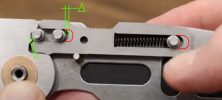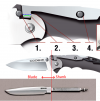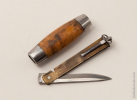Interesting thought. If you compare the Atlas Lock with Demko's Shark Lock, do you come to the same conclusion with this consideration?Just from sitting and having a look and think about it, I'm curious about what happens if you try to chop at something with an Atlas Lock. That's going to mean the blade is trying to fold backwards, and then everything is going into the front stop pin, which looks to have about... 45%? Of it's surface area in contact with the blade?
You are using an out of date browser. It may not display this or other websites correctly.
You should upgrade or use an alternative browser.
You should upgrade or use an alternative browser.
The Atlas Lock
- Thread starter tess_lawrie_fan
- Start date
Shorttime
Gold Member
- Joined
- Oct 16, 2011
- Messages
- 3,838
Interesting thought. If you compare the Atlas Lock with Demko's Shark Lock, do you come to the same conclusion with this consideration?
Yeah, looks like it. Blade is going to try to pivot around, well, the pivot, or shear through it, and the front stop pin is going to take the impact.
Shark Lock might be better in a way, because the stop pin is larger than in the Atlas Lock.
Heh. At the risk of pissing off everybody, the Shark Lock functions very similar to the AXIS Lock. Though the Shark has more blade-to-pin surface contact.
I'm fascinated by "strong" locks, but my fascination is mathematical, clinical, interested in applying numbers and science to the quest to make stronger locking mechanisms, and I wonder where I start annoying enthusiasts by asking "yes, but what do the numbers mean?"
- Joined
- Jan 21, 2012
- Messages
- 2,235
You can tell CS isn't serious about the numbers, or they'd be using torque rather than weight.Yeah, looks like it. Blade is going to try to pivot around, well, the pivot, or shear through it, and the front stop pin is going to take the impact.
Shark Lock might be better in a way, because the stop pin is larger than in the Atlas Lock.
Heh. At the risk of pissing off everybody, the Shark Lock functions very similar to the AXIS Lock. Though the Shark has more blade-to-pin surface contact.
I'm fascinated by "strong" locks, but my fascination is mathematical, clinical, interested in applying numbers and science to the quest to make stronger locking mechanisms, and I wonder where I start annoying enthusiasts by asking "yes, but what do the numbers mean?"
Honestly any of the atlas, triad, shark, or axis can be made arbitrarily strong by increasing the size of the components, so it's more about a specific implementation of a lock rather than the design.
Shorttime
Gold Member
- Joined
- Oct 16, 2011
- Messages
- 3,838
You can tell CS isn't serious about the numbers, or they'd be using torque rather than weight.
Honestly any of the atlas, triad, shark, or axis can be made arbitrarily strong by increasing the size of the components, so it's more about a specific implementation of a lock rather than the design.
I know, and that's what disappoints me. As much as I respect Mr. Demko, and understand that names sell knives, I would like to see innovation walking alongside science.
- Joined
- Aug 9, 2013
- Messages
- 118
The triadlock has 1 significant drawback - the tooth is abraded upon contact with the blade shank. I also wore out a few teeth on the Spiderco Chinook 2 and Delica, AG Russell K87, Buck 110 and the lock just stopped holding. Here I see a reserve for wear, like carbon brushes in DC motors. And I think, as it wears out, you can increase the notches with a file, where I marked it in red, and the lock will last even longer.


jux t
Gold Member
- Joined
- Jan 10, 2018
- Messages
- 2,328
What part of a blade are you calling the shank?The triadlock has 1 significant drawback - the tooth is abraded upon contact with the blade shank. I also wore out a few teeth on the Spiderco Chinook 2 and Delica, AG Russell K87, Buck 110 and the lock just stopped holding. Here I see a reserve for wear, like carbon brushes in DC motors. And I think, as it wears out, you can increase the notches with a file, where I marked it in red, and the lock will last even longer.
View attachment 1894651
I’m not an engineer, but it seems like a tri-ad lock will self adjust until it bottoms out. When/if it bottoms out, sanding the bottom most contact point will relieve that issue. The tri-ad also has a “reserve for wear.” With significant wear, the area of the atlas lock you marked in red will have to be filed, as well as the forked areas that surround the stop pin.
- Joined
- Aug 9, 2013
- Messages
- 118
The tooth wears and takes the shape of the shank (about the green line), when it is worn down to about the blue line, it will fold under the slightest load. I found this out when I decided to scratch my back with the spine of the blade of a folding knife and it folded over my fingers.
The photo showed, as I think, that is, the part that is immersed in the handle, some people think either the same way, or consider the part that comes after the hole around which the blade rotates to be the shank

The photo showed, as I think, that is, the part that is immersed in the handle, some people think either the same way, or consider the part that comes after the hole around which the blade rotates to be the shank

- Joined
- Apr 11, 2016
- Messages
- 18,670
Can't imagine the "tooth" on a TriAd wearing down to the point of not locking securely during a lifetime of normal use. I have a Delica, and the tooth is much shallower, so I could maybe see it on that. True, all lock types are going to have a finite life due to wear, but based on my usage, this is a non-issue.The tooth wears and takes the shape of the shank (about the green line), when it is worn down to about the blue line, it will fold under the slightest load. I found this out when I decided to scratch my back with the spine of the blade of a folding knife and it folded over my fingers.
The photo showed, as I think, that is, the part that is immersed in the handle, some people think either the same way, or consider the part that comes after the hole around which the blade rotates to be the shank
View attachment 1894663
Let us see the lock that you wore out"Normal use" is very different from person to person, apparently I'm out of luck. There are locks that hardly wear out.
View attachment 1894713
- Joined
- Jan 12, 2023
- Messages
- 433
I don't think its as strong as the triad, what I do think is they are trying to "hype" the atlas. For some reason, maybe something to to with patent.
- Joined
- Jan 12, 2023
- Messages
- 433
jux t
Gold Member
- Joined
- Jan 10, 2018
- Messages
- 2,328
Can you explain how this is a significant setback compared to any other common lock types where the friction of the lock bar (very) slowly abrades against the tang? Liner and frame locks abrade as well, and also have a travel limit.The triadlock has 1 significant drawback - the tooth is abraded upon contact with the blade shank.
Also, you’ve been asked before: can you show the tri-ad lock you or your uncle have worn out? If there’s significant play, make sure one of you haven’t accidentally switched the stop pin for the lock bar pin because they are nearly the same size and cause play when interchanged.
- Joined
- Jan 12, 2023
- Messages
- 433
Nice thing about forums and social media, any idiot can comment
- Joined
- Aug 9, 2013
- Messages
- 118
One worn one was sold, I'll try to find the second oneCan you explain how this is a significant setback compared to any other common lock types where the friction of the lock bar (very) slowly abrades against the tang? Liner and frame locks abrade as well, and also have a travel limit.
Also, you’ve been asked before: can you show the tri-ad lock you or your uncle have worn out? If there’s significant play, make sure one of you haven’t accidentally switched the stop pin for the lock bar pin because they are nearly the same size and cause play when interchanged.
Im no engineer either, so lets leave robustness determinations to.. engineers, shall we? Looking at pics of something new to market and claiming something is or is not strong is a fools errand. Fwiw, my atlas lock is entirely reliable and much better than my absolutely awful ad20.5I'm not impressed at all. I'm no engineer, so my opinion is just that, an opinion: stronger or not, the Tri-ad lock seems to be more reliable than the Atlas lock. The Atlas seems like a worsened, less robust version of the Shark lock.
jux t
Gold Member
- Joined
- Jan 10, 2018
- Messages
- 2,328
I have no skin in the game with those 2 locks, what didn’t you like about the ad20.5?Im no engineer either, so lets leave robustness determinations to.. engineers, shall we? Looking at pics of something new to market and claiming something is or is not strong is a fools errand. Fwiw, my atlas lock is entirely reliable and much better than my absolutely awful ad20.5
- Joined
- Apr 11, 2016
- Messages
- 18,670
Yeah, curious as well, as I have a 20.5 and a 20S and both are fantastic. Also had a 20 and it was great too.I have no skin in the game with those 2 locks, what didn’t you like about the ad20.5?
- Joined
- Mar 11, 2021
- Messages
- 174
The tooth wears and takes the shape of the shank (about the green line), when it is worn down to about the blue line, it will fold under the slightest load. I found this out when I decided to scratch my back with the spine of the blade of a folding knife and it folded over my fingers.
The photo showed, as I think, that is, the part that is immersed in the handle, some people think either the same way, or consider the part that comes after the hole around which the blade rotates to be the shank
View attachment 1894663
I consider this concern of the Tri-ad lock equivalent to warning someone that shooting too many rounds through their shotgun will wear the barrel too thin. Nobody, nobody has ever worn a triad lock down to that blue line, can't imagine how anyone could even if they tried. The most you will get from a completely worn to the max Tri-ad lock will be a little bit of up and down blade play, but they are never going to close on you.
If your blade did close on you, something else was going on.

